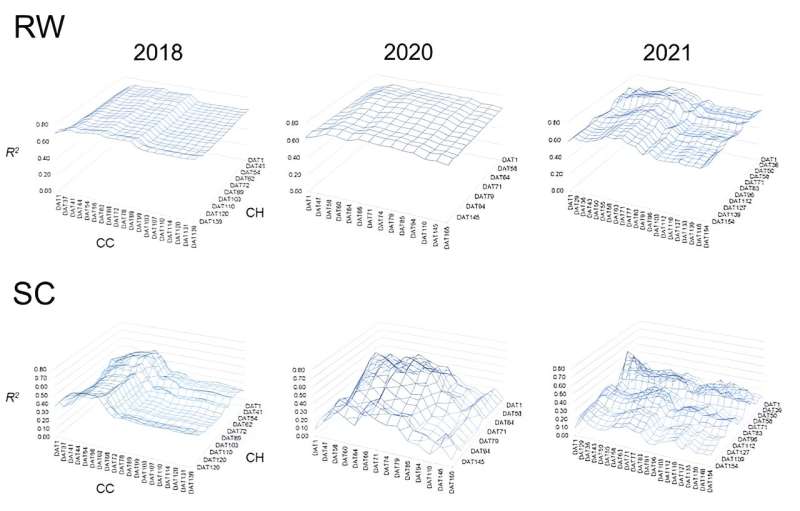This article has been reviewed according to Science X's editorial process and policies. Editors have highlighted the following attributes while ensuring the content's credibility:
fact-checked
trusted source
proofread
High throughput prediction of sugar beet root weight and sugar content using UAV derived growth dynamics

A research team employed an RGB camera on an unmanned aerial vehicle (UAV) to collect time series data on sugar beet canopy coverage and height. This data was used to predict root weight and sugar content with high accuracy. This innovative technique enhances breeder decision-making by providing pre-harvest selection criteria, reducing manual measurement needs. The UAV-based approach can also guide precision fertilization in production fields, demonstrating its value in improving agricultural efficiency and crop yield predictions.
Sugar beet (Beta vulgaris L.) is a vital crop for sugar production, yet its cultivation area has declined despite increased yields. Current research leverages heterosis to enhance sugar beet productivity, but traditional breeding methods are labor-intensive and inefficient. Although high-throughput UAV phenotyping demonstrated potential promise in other crops, it hasn't been fully explored for sugar beet yield and sugar content prediction.
A study published in Plant Phenomics on 11 Jun 2024, aims to develop a high-throughput UAV method to accurately predict sugar beet root weight and sugar content, improving breeding efficiency and cultivar development.
The research employed UAV-based high-throughput phenotyping to assess yield and foliar growth in sugar beet breeding fields. Over three seasons, canopy coverage (CC) and canopy height (CH) were monitored and analyzed.
In 2018, favorable conditions led to rapid early-season growth, while drought in 2020 reduced plant growth. In 2021, conditions were ideal, leading to good growth. Significant variation in root weight (RW) and sugar content (SC) was observed across the years, with analysis of variance (ANOVA) indicating significant differences among accessions.
UAV flights every 30 days provided detailed growth patterns, with logistic models fitting CC data and Gompertz models fitting CH data. Integrals of these models were used for genetic analysis, revealing significant general and specific combining abilities (GCA and SCA) for RW, SC, CCint120, and CHint120, suggesting both additive and non-additive gene actions. Multiple regression analysis predicted RW and SC using CC and CH data, achieving high correlation coefficients (R2 = 0.89 for RW and 0.83 for SC).
These findings highlight the potential of UAV-based phenotyping for efficient yield prediction and genetic analysis in the context of sugar beet breeding.
According to the study's lead researcher, Kazunori Taguchi, "Our simple yet robust solution demonstrates how state-of-the-art remote sensing tools and basic analysis methods can be applied to small-plot breeder fields for selection purpose."
In summary, this study utilized a UAV-based data-driven methodology to enhance breeder and farmer decision-making in sugar beet cultivation. This approach demonstrated that UAV-based phenotyping could efficiently predict sugar beet yield and assist in genetic analysis by providing significant data on growth patterns.
Future applications may extend this method to other crops, guiding precision agriculture and improving breeding programs by integrating advanced remote sensing and machine learning techniques.
More information: Kazunori Taguchi et al, High throughput prediction of sugar beet root weight and sugar content in a breeding field using UAV derived growth dynamics, Plant Phenomics (2024). DOI: 10.34133/plantphenomics.0209
Provided by NanJing Agricultural University





















